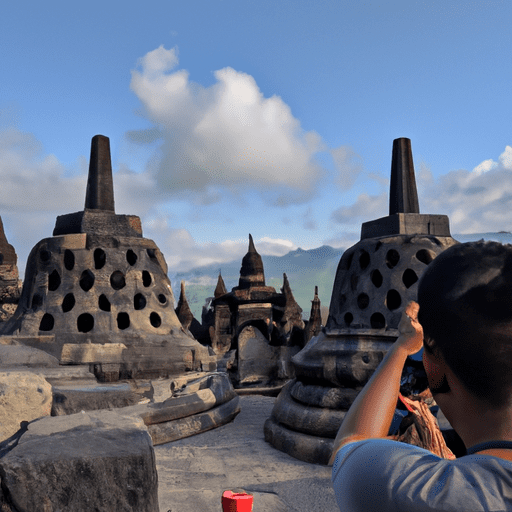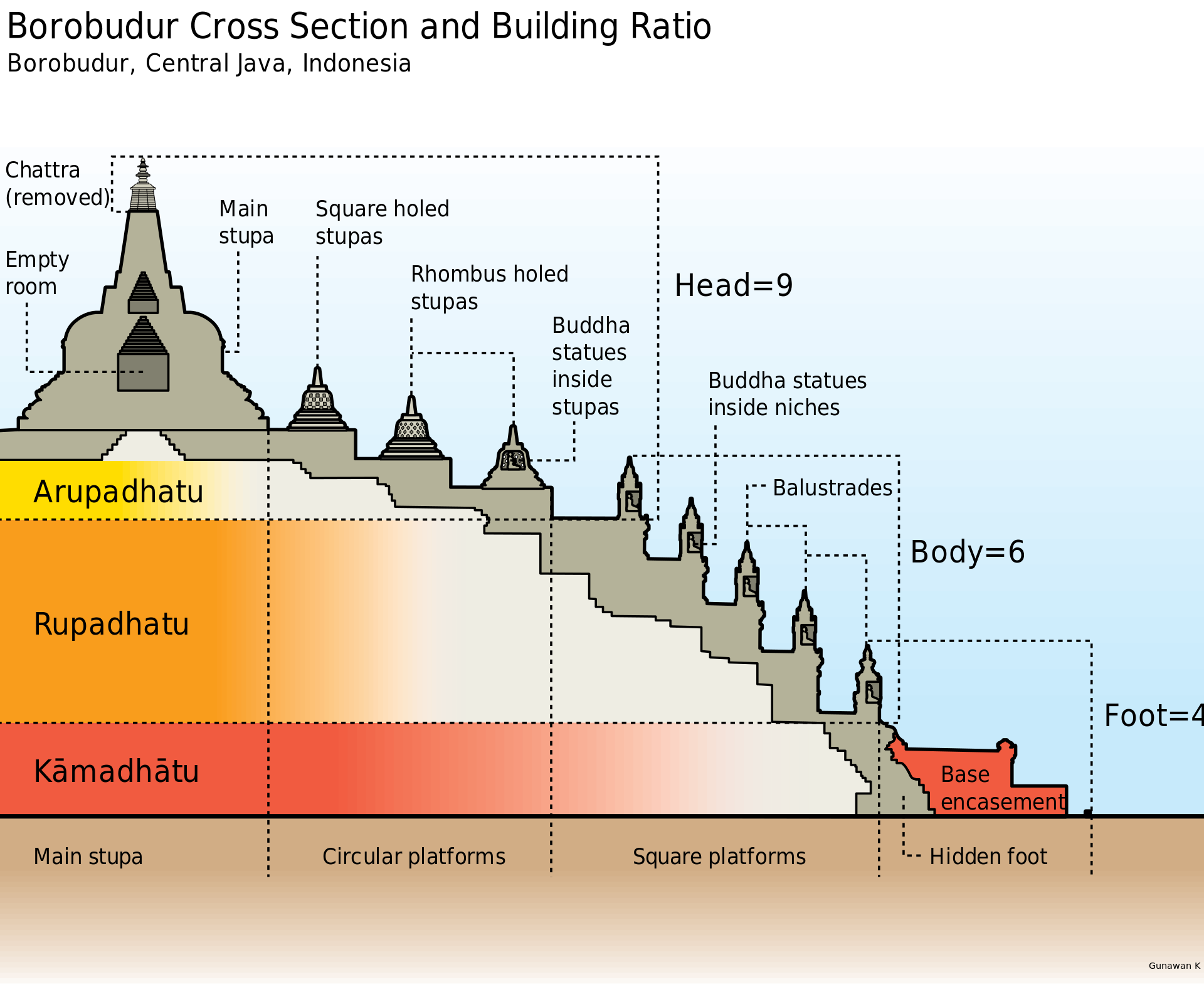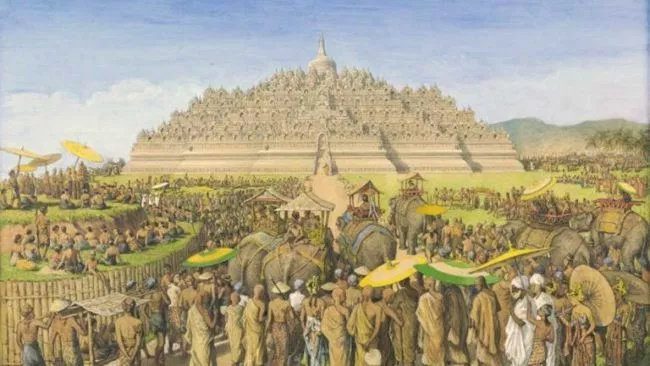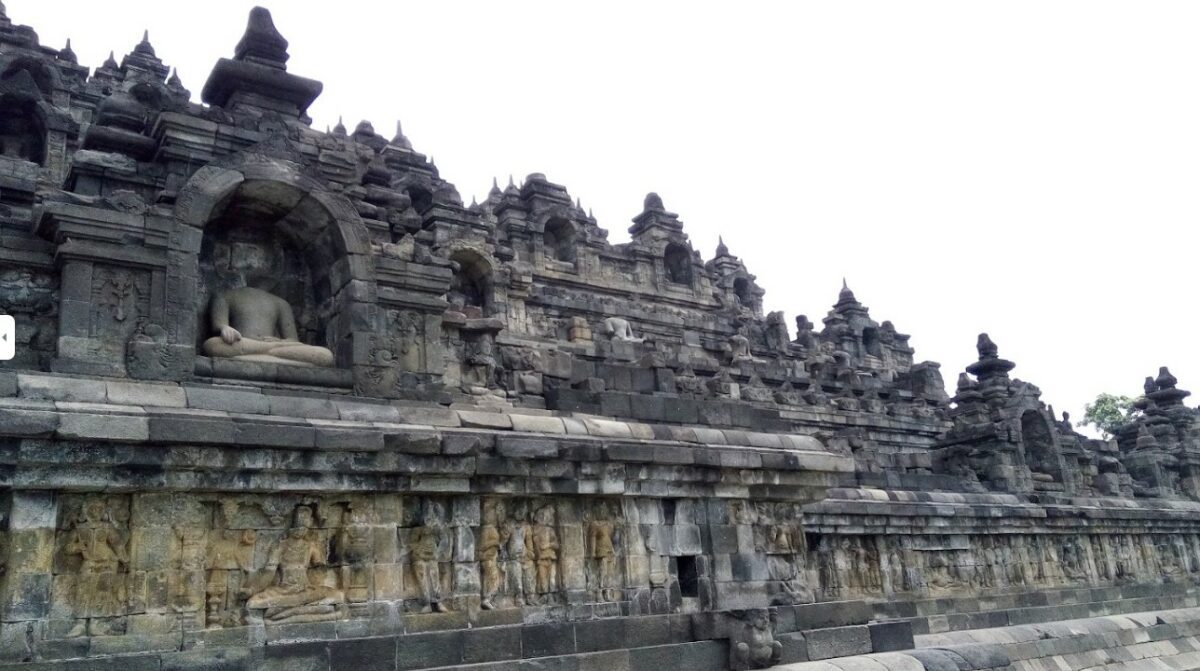The Origins and Architecture of the Construction of the Borobudur Temple – Borobudur (Javanese: ꦕꦤ꧀ꦝꦶꦧꦫꦧꦸꦝꦸꦂ , translit. Candhi Båråbudhur ) is a Buddhist temple located in Borobudur, Magelang, Central Java. This temple is located approximately 100 km southwest of Semarang, 86 km west of Surakarta, and 40 km northwest of Yogyakarta. This temple with many stupas was founded by adherents of Mahayana Buddhism around the year 800 AD during the reign of the Syailendra dynasty. Borobudur is the largest Buddhist temple or shrine in the world, as well as one of the largest Buddhist monuments in the world.
This monument consists of six square terraces on which there are three circular courtyards, the walls are decorated with 2,672 relief panels and originally there were 504 Buddha statues. Borobudur has the most complete and largest collection of Buddhist reliefs in the world. The largest main stupa is located in the center as well as crowning this building, surrounded by three circular rows of 72 perforated stupas in which there is a Buddha statue sitting cross-legged in a perfect lotus position with the Dharmachakra mudra ( turning the wheel of dharma).
This monument is a model of the universe and was built as a holy place to glorify Buddha as well as to function as a place of pilgrimage to guide mankind from the world of worldly desires to enlightenment and wisdom according to Buddhist teachings. Pilgrims enter via the east side and start the ritual at the base of the temple by walking around this sacred building in a clockwise direction, while continuing to ascend to the next steps through three levels of realms in Buddhist cosmology. The three levels are Kāmadhātu (the realm of lust), Rupadhatu (the realm of form), and Arupadhatu(intangible realm). On their way the pilgrims walk through a series of aisles and stairs to witness no less than 1,460 beautiful relief panels engraved on the walls and balustrades.
According to historical evidence, Borobudur was abandoned in the 14th century as the influence of the Hindu and Buddhist kingdoms on Java weakened and the influence of Islam began to enter. The world began to realize the existence of this building since it was discovered in 1814 by Sir Thomas Stamford Raffles, who at that time served as the British Governor General over Java. Since then Borobudur has undergone a series of rescue and restoration efforts. The largest restoration project was carried out from 1975 to 1982 under the efforts of the Government of the Republic of Indonesia and UNESCO, then this historic site was included in the list of World Heritage Sites.

The Origins of the Name Borobudur
Borobudur Stupa with Menoreh hills. Over the centuries this sacred building was forgotten.
In Indonesian, ancient religious buildings are called temples ; temple term is also used more broadly to refer to all the ancient buildings originating from the Hindu-Buddhist in the archipelago, such as gates , gate , and petirtaan (swimming baths and showers). The origin of the name Borobudur is unclear, although the original names of most temples in Indonesia are unknown.
The name Borobudur was first written in the book “History of the Island of Java” by Sir Thomas Stamford Raffles. Raffles wrote about a monument called borobudur , but there are no older documents that mention the exact same name. The only ancient Javanese text that gives clues about the existence of a sacred Buddhist building that may refer to Borobudur is Nagarakretagama, written by Mpu Prapanca in 1365.
The name Bore-Budur , which was later written BoroBudur , was probably written by Raffles in English grammar to refer to the village closest to the temple, namely the village of Bore (Boro); Most temples are often named after the village where the temple is located. Raffles also suspects that the term Budur may be related to the term Buda in Javanese which means “ancient” – hence meaning, “ancient Boro”. However, other archaeologists think that the name Budur comes from the term bhudhara which means mountain.
Many theories attempt to explain the name of this temple. One of them states that this name probably comes from the word Sambharabhudhara , which means “mountain” ( bhudara ) whose slopes are terraces. In addition there are several other folk etymologies, for example the word Borobudur comes from the saying “Buddhas” which due to a shift in sound becomes Borobudur .
Another explanation is that this name comes from the two words “bara” and “beduhur”. The word coal is said to have come from the word vihara , while there are also other explanations that consider coal to come from Sanskrit which means temple or monastery complex and beduhur which means “high”, or reminiscent of Balinese which means “above”. So, the meaning is a monastery or hostel on high ground.
Historian JG de Casparis in his dissertation to obtain a doctorate in 1950 argued that Borobudur was a place of worship. Based on the Karangtengah and Tri Tepusan inscriptions, Casparis estimates that the founder of Borobudur was a Mataram king from the Syailendra dynasty named Samaratungga, who undertook construction around 824 AD. The giant building was only completed during the time of his daughter, Ratu Pramudawardhani.
The construction of Borobudur is estimated to take half a century. In the Karangtengah inscription it is also mentioned about the awarding of sima land (tax free land) by Çrī Kahulunan (Pramudawardhani) to look after Kamūlān called Bhūmisambhāra . The term Kamūlān itself comes from the word mula which means the place of origin, a sacred building to honor the ancestors, possibly the ancestors of the Sailendra dynasty. Casparis estimates that Bhūmi Sambhāra Bhudhāra in Sanskrit which means “Hill of the ten levels of bodhisattwa virtues”, is the original name of Borobudur.

Borobudur Building Architecture
Borobudur is a masterpiece of Indonesian Buddhist art, as an example of the pinnacle of achieving the harmony of architectural techniques and the aesthetics of Buddhist art in Java. This building was inspired by dharma ideas from India, namely stupas and mandalas, but is believed to also be a continuation of local elements; megalithic structures punden terraces or terraced pyramids found from the prehistoric period of Indonesia. As a combination of native Indonesian ancestor worship and the struggle to reach Nirvana in Buddhism.
Design Concept
In essence, Borobudur is a stupa which, when viewed from above, forms a large Mandala pattern. Mandalas are intricate patterns composed of squares and concentric circles that symbolize the cosmos or universe which are commonly found in Vajrayana-Mahayana Buddhists. The ten courtyards owned by Borobudur clearly illustrate the philosophy of the Mahayana school which simultaneously describes the cosmology of the concept of the universe, as well as the levels of the mind in Buddhism.
Like a book, Borobudur describes the ten Bodhisattva levels that must be passed to reach perfection to become a Buddha. The floor plan of the square measures 123 meters (404 ft) on each side. This building has nine terraces, namely the bottom six terraces are square and the top three terraces are circular.
In 1885, accidentally found a hidden structure at the foot of Borobudur. This hidden foot has reliefs of which 160 are about Karmawibhangga . In this relief panel there are carved characters which are instructions for the sculptor to create scenes in relief images. This original foot is covered by the addition of a stone structure that forms a fairly large courtyard, its true function is still a mystery.
Initially, it was suspected that the addition of these legs was to prevent the monument from sliding. Another theory proposes that the addition of the legs is due to an error in the design of the original legs, and is not in accordance with Wastu Sastra, an Indian book on architecture and urban planning. Whatever the reason for the addition of these legs, the addition and manufacture of these additional legs is done carefully by considering religious, aesthetic and technical reasons.
The three levels of the spiritual realm in Buddhist cosmology are as follows.
1. Kamadhatu
The foot of Borobudur symbolizes Kamadhatu , namely the world which is still ruled by kama or “low desire”. This section is mostly covered by piles of stones which are thought to have been made to strengthen the construction of the temple. At the original foot which is covered by this additional structure, there are 160 panels of Karmawibhangga’s story which are now hidden. A small additional structure in the southeast corner is set aside, so one can still see some of the relief in this section. The additional foot of andesite stone structure that covers the original foot has a volume of 13,000 cubic meters.
2. Rupadhatu
The four terraced steps that form a circular passageway, the walls of which are decorated with relief galleries, are called Rupadhatu by experts . The floor is square. Rupadhatu consists of four passages with 1,300 relief images. The total relief is 2.5 km long with 1,212 decorative carved panels. Rupadhatu is a world that has been able to free itself from lust, but is still bound by shape and form. This level represents the intermediate realm, that is, between the lower realms and the upper realms .
In this part of the Rupadhatu , Buddha statues are found in niches or recesses of the walls above the balustrades or passages. Originally, there were 432 Buddha statues in open niches along the outer side of the balustrade. On the balustrades there is a slight difference in design which symbolizes the transition from the Kamadhatu realm to the Rupadhatu realm ; The lowest balustrades are crowned with ratna, while the four levels of balustrades above are crowned with stupika (small stupas). The rectilinear terraces are richly decorated and carved in relief.
3. Arupadhatu
In contrast to the Rupadhatu halls , which are rich in reliefs, from the fifth to the seventh floor, the walls are devoid of relief. This level is called Arupadhatu (which means no tangible form or not). Circular floor plan. This level symbolizes the upper realm, when humans are free from all desires and bonds of form and appearance, but have not yet reached nirvana.
In the courtyard of the circle there are 72 two small stupas arranged in three rows surrounding a large stupa as the main stupa. This small bell-shaped stupa is arranged in 3 circular terraces, each numbering 32, 24 and 16 (total 72 stupas). The two lower terraces of the stupa are larger with a rhombus-shaped hole, the top terrace of the stupa is slightly smaller and the hole is in the shape of a square box.
Buddha statues are placed in stupas which are covered with holes like in a cage. From outside the statues were still vaguely visible. This design cleverly explains the concept of transition to a state of formlessness, i.e. the Buddha statue is present, but invisible.
The highest level that describes the lack of perfect form is symbolized in the form of the largest and highest stupa. The stupa is described as plain without any holes. In this largest stupa, an incomplete Buddha statue or also called an incomplete Buddha was found, which was mistaken for an Adibuddha statue , even though through further research there was never a statue in the main stupa, the unfinished statue was the fault of the sculptor at that time. formerly.
According to belief, statues that go wrong during the manufacturing process cannot be tampered with. Archaeological excavations carried out in the courtyard of this temple unearthed many statues like this. The main stupa that is left empty is thought to mean the highest wisdom, namely absoluteness, solitude, and complete absence when the human soul is free from desire, desire, and form and is free from the cycle of samsara.

The arrangement and division of story reliefs on the walls and balustrades of the temple are as follows.
1. Karmawibhangga
In accordance with the symbolic meaning at the foot of the temple, the reliefs that adorn the veiled batur walls depict the law of karma. Karmawibhangga is a text that describes the teachings of karma, namely the causes and effects of good and evil actions. The row of reliefs is not a serial story, but each frame depicts a story that has a causal relationship.
The relief not only gives an illustration of human disgraceful actions accompanied by the punishment they will receive, but also human good deeds and rewards. As a whole, it is a depiction of human life in a cycle of birth, life and death (samsara) that never ends, and by Buddhism it is this chain that will end towards perfection. Now, only the southeastern part is open and can be seen by visitors. A complete photo of the Karmawibhangga relief can be seen at the Karmawibhangga Museum on the north side of Borobudur temple.
2. Lalitawistara
It is a depiction of the history of the Buddha in a series of reliefs (but not a complete history) which begins with the descent of the Buddha from the Tushita heaven, and ends with the first sermon in the Deer Park near the city of Banaras. These reliefs line up from the stairs on the south side, after passing a series of reliefs of 27 frames starting from the east side of the stairs. The 27 frames depict busyness, both in heaven and on earth, in preparation for welcoming the presence of the Bodhisattwa’s final incarnation as a future Buddha.
The relief depicts the birth of the Buddha in this statue as Prince Siddhartha, son of King Suddhodana and Empress Maya from Kapilawastu Country. The reliefs number 120 frames, which end with the first discourse, which is symbolically stated as the Turning of the Dharma Wheel. The teachings of the Buddha are called dharma which also means “law”, while dharma is symbolized as a wheel.
3. Jatakas and Awadana
The Jatakas are various stories about the Buddha before being born as Prince Siddhartha. Its content is the highlight of good deeds, such as self-sacrifice and helpfulness that distinguishes the Bodhisattva from any other being. Several Jataka stories feature fables, namely stories involving animal characters who act and think like humans. In fact, the accumulation of merit or good deeds is a preparatory stage in the quest for Buddhahood.
The Awadana is basically almost the same as the Jataka, but the perpetrators are not the Bodhisattwa, but other people and the stories are compiled in the Diwyawadana book which means noble deeds of deity, and the Awadanasataka book or one hundred Awadana stories. In the reliefs of the Borobudur temple, Jataka and Awadana are treated the same, meaning that both are in the same row without being distinguished. The most famous collection from the life of the Bodhisattva is the Jatakamala or Jataka tales, by the poet Aryasura who lived in the 4th century AD.
4. Gandawyuha
A series of reliefs adorning the walls of the 2nd aisle, is the story of Sudhana who wanders tirelessly in his search for the Supreme Knowledge of the Ultimate Truth by Sudhana. His depiction in 460 frames is based on the Mahayana Buddhist scripture entitled Gandawyuha , and the closing part is based on another book, namely Bhadracari .
So, that’s a brief explanation of the origins and architecture of the construction of the Borobudur Temple . Borobudur is still used as a place of religious pilgrimage to this day; every year Buddhists who come from all over Indonesia and abroad gather at Borobudur to commemorate the Vesak Trisuci. Regarding tourism, Borobudur is the single tourist attraction in Indonesia that is visited by the most tourists. On February 11, 2022, the government formalized the status of Borobudur Temple again as a place of worship for Buddhists in Indonesia and the world.
- The Founder of the Kutai Kingdom: History, Heyday, and Legacy
- The Founder of the Majapahit Empire: History and the First King
- Founder of the Singhasari Kingdom: Origins and a Brief History
- History of the Founders of the Sriwijaya Kingdom and Their Lineages
- History of the Kingdom of Sunda and its Legacy
